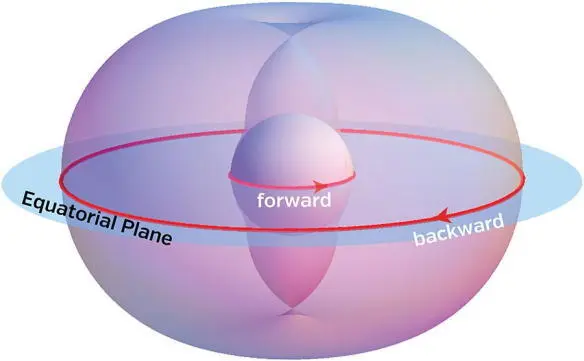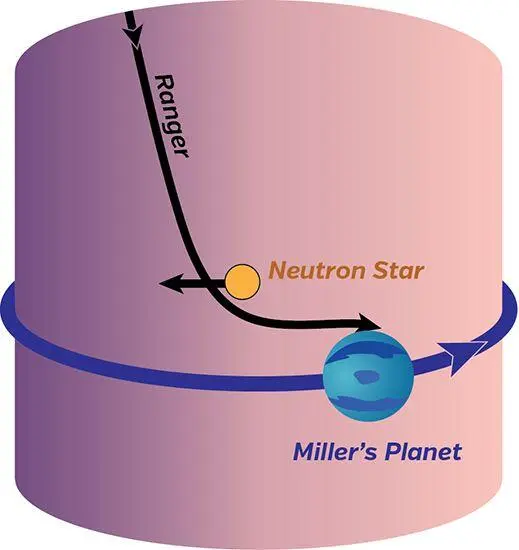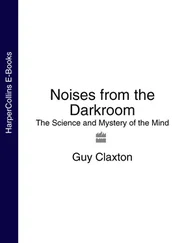The region of space occupied by the shell of fire above and below the equatorial plane is depicted in Figure 6.4. It is a large, annular region. I omit the warping of space from this picture; it would get in the way of showing the shell of fire’s full three dimensions.

Fig. 6.4. The annular region around Gargantua, occupied by the shell of fire.
Figure 6.5 shows some examples of photon orbits (light rays) trapped, temporarily, in the shell of fire.
The black hole is at the center of each of these orbits. The leftmost orbit winds around and around the equatorial region of a small sphere, traveling always forward, in the same direction as Gargantua’s spin. It is nearly the same as the bottom (inner) red orbit in Figures 6.3 and 6.4. The next orbit in Figure 6.5 winds around a slightly larger sphere, in a nearly polar and slightly forward direction. The third orbit is larger still, but backward and nearly polar. The fourth is very nearly equatorial and backward, that is, nearly the upper (outer) red equatorial orbit of Figures 6.3 and 6.4. These orbits are actually inside each other; I pulled them apart so they are easier to see.
Some photons that are temporarily trapped in the shell of fire escape outward; they spiral away from Gargantua. The rest escape spiraling inward; they spiral toward Gargantua and plunge through its horizon. The nearly trapped but escaping photons have a big impact on Gargantua’s visual appearance in Interstellar . They mark the edge of Gargantua’s shadow as seen by the Endurance ’s crew, and they produce a thin bright line along the shadow’s edge: a “ring of fire” (Chapter 8).

Fig. 6.5. Examples of light rays (photon orbits) temporarily trapped in the shell of fire, as computed using Einstein’s relativistic equations.
7
Gravitational Slingshots

Navigating a spacecraft near Gargantua is hard because the speeds are very high. To survive, a planet or star or spacecraft must counteract Gargantua’s huge gravity with a comparably huge centrifugal force. This means it must move at very high speed. Near the speed of light, it turns out. In my science interpretation of Interstellar , the Endurance , parked at ten Gargantua radii while the crew visit Miller’s planet, moves at one-third the speed of light: c /3, where c represents the speed of light. Miller’s planet moves at 55 percent the speed of light, 0.55 c .
To reach Miller’s planet from the parking orbit in my interpretation (Figure 7.1), the Ranger must slow its forward motion from c /3 to far less than that, so Gargantua’s gravity can pull it downward. And when it reaches the vicinity of the planet, the Ranger must turn from downward to forward. And, having picked up far too much speed while falling, it must slow by about c /4 to reach the planet’s 0.55 c speed and rendezvous with it.

Fig. 7.1. The Ranger’s trip to Miller’s planet, in my interpretation of Interstellar .
What mechanism can Cooper, the Ranger’s pilot, possibly use to produce these huge velocity changes?
Twenty-First-Century Technology
The required changes of velocity, roughly c /3, are 100,000 kilometers per second (per second, not per hour!).
By contrast, the most powerful rockets we humans have today can reach 15 kilometers per second: seven thousand times too slow. In Interstellar , the Endurance travels from Earth to Saturn in two years at an average speed of 20 kilometers per second, five thousand times too slow. The fastest that human spacecraft are likely to achieve in the twenty-first century, I think, is 300 kilometers per second. That would require a major R&D effort on nuclear rockets, but it is still three hundred times too slow for Interstellar ’s needs.
Fortunately, Nature provides a way to achieve the huge speed changes, c /3, required in Interstellar: gravitational slingshots around black holes far smaller than Gargantua .
Slingshot Navigation to Miller’s Planet
Stars and small black holes congregate around gigantic black holes like Gargantua (more on this in the next section). In my science interpretation of the movie, I imagine that Cooper and his team make a survey of all the small black holes orbiting Gargantua. They identify one that is well positioned to gravitationally deflect the Ranger from its near circular orbit and send it plunging downward toward Miller’s planet (Figure 7.2). This gravity-assisted maneuver is called a “gravitational slingshot,” and has often been used by NASA in the solar system—though with the gravity coming from planets rather than a black hole (see the end of the chapter).
This slingshot maneuver is not seen or discussed in Interstellar , but the next one is mentioned, by Cooper: “Look, I can swing around that neutron star to decelerate,” he says. Deceleration is necessary because, having fallen under Gargantua’s huge gravitational pull, from the Endurance ’s orbit to Miller’s orbit, the Ranger has acquired too much speed; it is moving c /4 faster than Miller’s planet. In Figure 7.3, the neutron star, traveling leftward relative to Miller’s planet, deflects and slows the Ranger’s motion so it can rendezvous gently with the planet.

Fig. 7.2. The Ranger performs a slingshot maneuver around a small black hole, deflecting it downward, toward Miller’s planet.

Fig. 7.3. Slingshot around a neutron star enables the lander to rendezvous with Miller’s planet.
Now, there is a feature of these slingshots that could be very unpleasant. Indeed, deadly: tidal forces (Chapter 4).
To change velocities by as much as c /3 or c /4, the Ranger must come close enough to the small black hole and neutron star to feel their intense gravity. At those close distances, if the deflector is a neutron star or is a black hole with radius less than 10,000 kilometers, the humans and the Ranger will be torn apart by tidal forces (Chapter 4). For the Ranger and humans to survive, the deflector must be a black hole at least 10,000 kilometers in size (about the size of the Earth).
Now, black holes that size do occur in Nature. They are called intermediate-mass black holes, or IMBHs, and despite their big size, they are tiny compared to Gargantua: ten thousand times smaller.
So Christopher Nolan should have used an Earth-sized IMBH to slow down the Ranger, not a neutron star. I discussed this with Chris early in his rewrites of Jonah’s screenplay. After our discussion, Chris chose the neutron star. Why? Because he didn’t want to confuse his mass audience by having more than one black hole in the movie. One black hole, one wormhole, and also a neutron star, along with Interstellar ’s other rich science, all to be absorbed in a fast-paced two-hour film; that was all Chris thought he could get away with. Recognizing that strong gravitational slingshots are needed to navigate near Gargantua, Chris included one slingshot in Cooper’s dialog, at the price of using a scientifically implausible deflector: the neutron star instead of a black hole.
Читать дальше


















